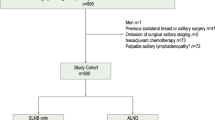Abstract
The prediction of clinical outcome of patients after breast cancer surgery plays an important role in medical tasks such as diagnosis and treatment planning. Survival estimations are currently performed by clinicians using non-numerical techniques. Artificial neural networks are shown to be a powerful tool for analyzing data sets where there are complicated nonlinear interactions between the input data and the information to be predicted. In this paper, a new estimation to set the maximum bound on prediction accuracy is presented, based on the approximation of the a posteriori probability of Bayes by feed-forward three-layer neural networks. This result is applied to different patients' follow-up time intervals, in order to obtain the best prediction accuracy for the correct classification probability of patient relapse after breast cancer surgery using clinical-pathological data (tumor size, patient age, menarchy age, etc.), which were obtained from the Medical Oncology Service of the Hospital Clinico Universitario of Malaga, Spain. Different network topologies and learning parameters are investigated to obtain the best prediction accuracy. The actual results show as, after training process, the final model is appropriate to make predictions about the relapse probability at different times of follow-up.
Similar content being viewed by others
References
W.L. McGuire, A.T. Tandom, D.C. Allred, G.C. Chamnes, and G.M. Clark, “How to use prognostic factors in axillary nodenegative breast cancer patients,” J. Natl. Cancer Inst., vol. 82, pp. 1006-1015, 1990.
R.P. Gorman and T.J. Sejnowski, “Analysis of hidden units in a layered network trained to classify Sonar targets,” Neural Networks, vol. 1, pp. 75-89, 1988.
Mc O'Neill, “Training back-propagation neural networks to de-fine and detect DNA-binding sites,” Nucleic Acids Res., vol. 19, pp. 313-318, 1991.
N. Qian and T.J. Sejnowski, “Predicting the secondary structure of globular proteins using neural network models,” J. Mol. Biol., vol. 202, pp. 865-884, 1988.
H. White, “Learning in artificial neural networks: A statistical approach,” Neural Computation, vol. 1, pp. 425-464, 1989.
W.G. Baxt, “Application of neural networks to clinicla medicine,” Lancet, vol. 346, pp. 1135-1138, 1995.
P.M. Ravdin and G.M. Clark, “A practical application of neural network analysis for predicting outcome of individual breast cancer patients,” Breast Cancer Research and Treatment, vol. 22, pp. 285-293, 1992.
M. Jefferson, N. Pendleton, B. Lucas, and M. Horan, “Comparison of a genetic algorithm neural network with logistic regression for predicting outcome after surgery for patients with nonsmall cell lung carcinoma,” American Cancer Society, 1996.
S.A. Kaplan and P. Meier, “Nonparametric estimation from incomplete observations,” J. Am. Stat. Assoc., vol. 53, pp 457-481, 1958.
D.R. Cox: “Regression models and life tables,” J.R. Stat. Soc., vol. 34, pp. 187-220, 1972.
E. Alba et al., Estructura del patron de recurrencia en el cancer de mama operable (CMO) tras el tratamiento primario. Implicaciones acerca del conocimiento de la historia natural de la enfermedad. 7° Congreso de la Sociedad Española de Oncología Médica. Sitges, Barcelona. Abril 1999.
R.O. Duda and P.E. Hart, Pattern Classification and Scene Analysis, John Wiley and Sons: New York, 1973.
K. Funahashi, “Multilayer neural networks and Bayes decision theory,” Neural Networks, vol. 11, pp. 209-213, 1998.
R. Rojas, “A short proof of the posterior probability property of classifier neural networks,” Neural Computation, vol. 8, pp. 41-43, 1996.
G.E. Hinton,“Connectionist learning procedures,” Technical report CMU-CS-87-115, Carnegie-Mellon University, Pittsburgh, PA, 1987.
R.M. Golden: Mathematical Methods for Neural Network Analysis and Design, MIT Press: Cambridge: MA, 1996.
S. Fahlma and C. Lebiere, “The Cascade Correlation Learning Architecture,” Technical report CMU-CS-90-100, Carnegie-Mellon University, Pittsburgh, PA, 1990.
D.W. Patterson: Artificial Neural Networks, Theory and Applications, Prentice Hall, 1996.
S. Amari, N. Murata, K.R. Muller, M. Finke, and H. Yang, “Statistical theory of overtraining-Is cross-validation asymptotically effective?” Advances in Neural Information Processing Systems, vol. 8, pp. 176-182, 1996.
P. Janssen et al., “Model structure selection for multivariable systems by cross-validation,” International Journal of Control, vol. 47, pp. 1737-1758, 1988.
Rights and permissions
About this article
Cite this article
Gómez-Ruiz, J., Jerez-Aragonés, J., Muñoz-Pérez, J. et al. A Neural Network Based Model for Prognosis of Early Breast Cancer. Applied Intelligence 20, 231–238 (2004). https://doi.org/10.1023/B:APIN.0000021415.88365.c4
Issue Date:
DOI: https://doi.org/10.1023/B:APIN.0000021415.88365.c4




